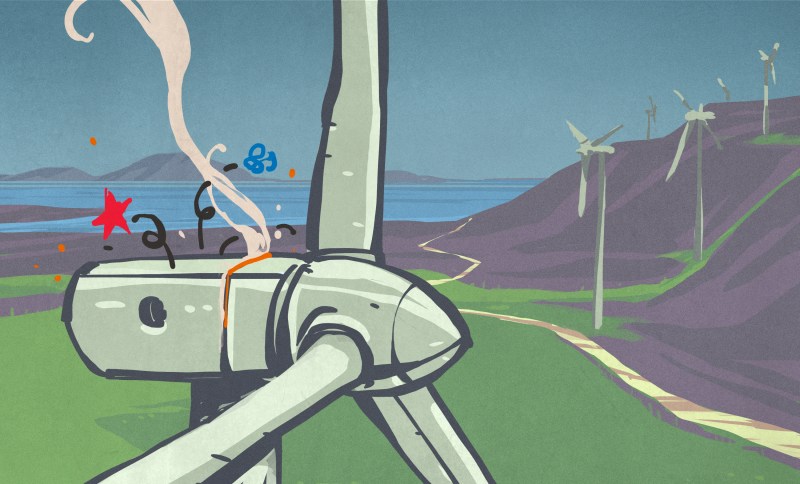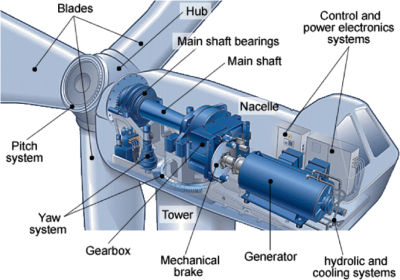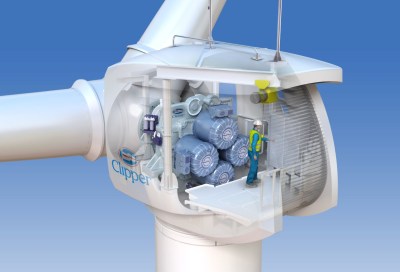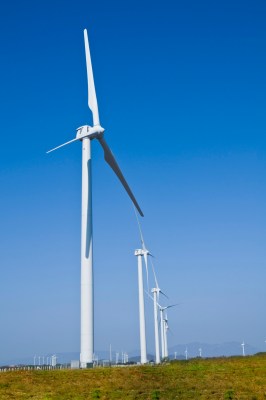
The first modern wind turbines designed for bulk electricity generation came online gradually throughout the 80s and early 90s. By today’s standards these turbines are barely recognizable. They were small, had low power ratings often in the range of tens to hundreds of kilowatts, and had tiny blades that had to rotate extremely quickly.
When comparing one of these tiny machines next to a modern turbine with a power rating of 10 or more megawatts with blades with lengths on the order of a hundred meters, one might wonder if there is anything in common at all. In fact, plenty of turbines across the decades share fundamental similarities including a three-blade design, a fairly simple gearbox, and a single electric generator. While more modern turbines are increasingly using direct-drive systems that eliminate the need for a gearbox and the maintenance associated with them, in the early 2000s an American wind turbine manufacturer named Clipper Windpower went in the opposite direction, manufacturing wind turbines with an elaborate, expensive, and heavy gearbox that supported four generators in each turbine. This ended up sealing the company’s fate only a few years after the turbines were delivered to wind farms.
Some history: the largest terrestrial wind turbines were approaching the neighborhood of 2 megawatts, but some manufacturers were getting to these milestones essentially by slapping on larger blades and generators to existing designs rather than re-designing their turbines from the ground up to host these larger components. This was leading to diminishing returns, as well as an increased amount of mechanical issues in the turbines themselves, and it was only a matter of time before the existing designs wouldn’t support this trend further. Besides increased weight and other mechanical stresses on the structure itself, another major concern was finding (and paying for) cranes with enough capacity to hoist these larger components to ever-increasing heights, especially in the remote locations that wind farms are typically located. And cranes aren’t needed just for construction; they are also used whenever a large component like a generator or blade needs to be repaired or replaced.

Looking at the problems with wind turbines in this era, Clipper Windpower arrived on the scene with a completely novel turbine layout which they thought would solve these issues. The main design difference was the use of four generators working in tandem rather than a single large generator. Their design was known as the Liberty turbine, producing 2.5 megawatts of power at maximum output.
In 2007, it was the largest wind turbine available in the United States. The design meant that a generator failure wouldn’t completely take a turbine offline, as they could run with less than four generators, and the generators were small enough on their own to be hoisted up and down easily by the turbine’s 2-ton crane. Plenty of other turbines have cranes for hoisting tools and smaller components, but unlike the Clipper Liberty turbine, in a standard single-generator layout the replacement of a generator would generally mean contracting out a much larger crane.

In theory, there were plenty of advantages to this design besides the physical size of the generators. The distributed loads on the gearbox meant less mechanical stresses on the turbine’s physical structure. Generators with different power ratings could, in theory, be used as well, allowing the turbine to produce energy across a wider range of wind conditions than one with a single generator. Besides the technical aspects of the turbine itself, Clipper hoped to innovate in other ways as well. They attempted to set up temporary turbine manufacturing facilities at the planned sites of wind farms, meaning virtually no transportation costs for high-dollar items like turbine blades.
What Could Possibly Go Wrong?
But problems quickly appeared with turbines shortly after being placed in service, the most devastating of which surrounded the enormously complex gearbox. To explain this, we need to first look at why a gearbox is included in a wind turbine at all. For the most part, the synchronous electrical generators often used in older wind turbines need to operate near a specific rotational speed to send energy to the electrical grid, often 3600 rpm for a 2-pole generator or 1800 rpm for a four-pole generator, in places with a 60 Hz power grid. This is orders of magnitude faster than the rotational speed of the wind turbine’s blades and hub assembly, also known as a rotor, which is somewhere in the neighborhood of 10 rpm to 30 rpm. Most turbines of this era, including Clipper Liberty turbines, relied on a gearbox to couple the rotor to the generator even if there was only a single generator in the turbine.
The difficulty of designing and manufacturing a reliable gearbox that needed to accommodate four generators was not something Clipper was entirely prepared for, though. The first issues that began cropping up involved timing issues with the gear sets inside the gearbox (followed shortly by systemic blade problems, but that’s a little outside this scope). Specific details are sparse, but similar to the timing mechanisms for the valve trains in internal combustion engines, the gears inside the Clipper gearbox needed to be in near-perfect synchronization with each other in order to drive the generators properly. The gears, produced by a third party, weren’t manufactured to the correct tolerances so after only months of energy production, the gears were beginning to fail.
Since the Liberty turbine was produced with the intention of reducing the impact of generator failures by placing all of the onus on a complex gearbox, the fact that these turbines’ gearboxes began rapidly failing in the late 2000s was a major setback. Not only does a failed gearbox take the turbine out of service, but now it was possible that a heavy crane would be needed to replace it, if a replacement from the fledgling wind turbine manufacturer was available at all. Clipper was quickly inundated with warranty claims for their gearboxes, which even more rapidly led to the financial failure of the company. The timing of this was unfortunate as well, as warranty claims for the failed gearboxes correlated with the 2008 financial crisis. Clipper filed for bankruptcy in 2012 amid much investor consternation, as many investors in the company ended up being the wind farms who had originally purchased the turbines.
Feature Creep
Here in the present, it is becoming rare to see an original Clipper turbine still in operation. To keep these wind farms in service and fulfilling their power purchase agreements, a much easier option is to simply replace all the Clipper components “up tower”, such as the entire nacelle, rotor, and/or blades, with those from a competitor, leaving almost no original components besides the tower. Unfortunately, unlike other single-generator turbines which use more standardized parts and can therefore survive capitalistic machinations such as bankruptcies and buyouts more readily by sourcing parts from other manufacturers, Clipper built themselves into a prison of their own making. Originally hailed as industry leaders, the complexity of their drivetrain and its single point of failure ended up being their own undoing.
While plenty might look to those behind the company, this isn’t a story of an out-of-touch investor or venture capital firm attempting to “disrupt” an industry they knew nothing about, like certain other billionaires in the news lately who have accidentally bought companies they don’t fundamentally understand. Clipper’s founder was originally the founder of Zond, one of the largest and most successful wind turbine producers of the 80s and 90s. Coincidentally, Zond was acquired by Enron in 1997, which was then acquired by General Electric after Enron suffered slight financial difficulties, making GE one of the major competitors of Clipper during the mid-00s. Instead, this is more of a story of feature creep on a massive scale, and of going out of your way to solve a problem that doesn’t really exist, and introducing much more serious problems as a result.

Indeed, what really happened to Clipper, which we can only see now with the benefit of hindsight, was that the designers made some questionable choices when first conceiving these turbines. For one, designing a completely new turbine layout was sure to be rife with unforeseen problems. For another, the problems they were attempting to solve wouldn’t end up becoming the industry bottlenecks that Clipper predicted. More cranes and crane operators were found as the industry expanded in megawatt ratings, larger component sizes, heights, and weights, and in the sheer numbers needed to support a rapidly increasing number of wind farms.
Additionally, most modern large-scale wind farms are built in places with fairly predictable wind characteristics, so multiple generators with different power curves didn’t turn out to have the benefit it was thought to. And generator failures turned out to not have the devastating impacts that Clipper forecasted, either. There are some theoretical benefits to multiple-generator layouts, but replacing a single point of failure in a relatively simple electrical machine, the generator, with a single point of failure in an enormously complicated mechanical device, the gearbox, turned out to create many more problems than it ultimately solved.
While there is still a company called Clipper today, with a shop in Iowa that repairs gearboxes and provides other wind-related services, it has been sold off twice since its bankruptcy and exists as a shell of its former self. At this point the Clipper Liberty turbine is nearing 20 years old, and with wind farms looking to repower their turbines they often turn to technologies that are more proven and with higher megawatt ratings rather than repairing and maintaining this niche turbine. Clipper’s story is not an altogether uncommon story either, where a company is hyped to solve a problem they claim is a major issue, only for their product to lead to disappointment when finally released. Other examples include the Segway, Google Glass, or the attempt to bring 3D televisions to mass market. These products and the Clipper Liberty turbine are case studies in the importance of understanding consumer needs, market demand, and addressing genuine pain points when developing innovative technologies. Failing to understand these ideas can result in disastrous consequences.
Clipper Windpower: Solutions in Search of Problems
Source: Manila Flash Report
0 Comments